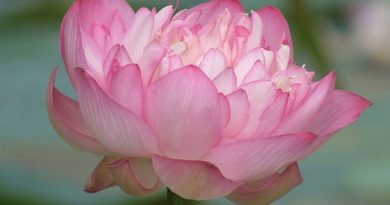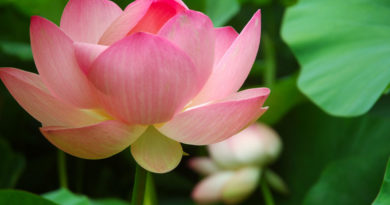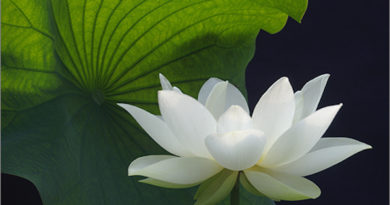FUNDAMENTALS OF VIPASSANA MEDITATION – CHAPTER IV: The Right Method
When you meditate, you have to meditate with method. Only the right method can bring about insight. If you look upon things as being permanent, how can there be insight? If you look upon them as being happy, beautiful, as soul, as ego, how can there be insight?
Mind and matter are impermanent things. These impermanent things you have to meditate on to see them as they really are, as being impermanent. They rise and pass away and keep on oppressing you, so they are dreadful, they are sufferings. You have to meditate to see them as they are, as sufferings. They are processes lacking in a personality, a soul, a self. You have to meditate to see that there is no personality, no soul, no self. You must try to see them as they really are.
So, every time you see, hear, touch or perceive, you must try to see the mental and material processes that rise through the six sense doors as they really are. When you see, the seeing is real. This you must note seeing; seeing. In the same way, when you hear, note hearing. When you smell, note smelling. When you taste, note tasting When you touch, note touching. Tiredness, hotness, aches, and such unbearable and unpleasant sensations arise from contact too. Observe them tiredness, hot, pain, and so on. Thoughts, ideas, may also turn up. Note them: thinking, imagining, pleasure, delight, as they arise. But to the novice it is hard to observe all that come up through the six sense doors. He must begin with just a few.
You meditate like this. When you breathe in and out, the way the abdomen moves rising and falling is especially conspicuous. You begin observing this movement. The movements of rising you observe as rising. The movements of falling you observe as falling. This observation of rising and falling is void of the lingo of the scriptures. People who are not used to meditation practice speak of it in contempt: “This rising and falling business has nothing to do with the scriptures. It is nothing.” Well may they think it is nothing because it is not done up in scriptural Jargon.
Theoretically, however, it is something. The rising is real, the falling is real, the moving air element is real. We have used the colloquial words rising and falling for conveniences sake. In scriptural terminology, the rising falling is the air element. If you observe the abdomen attentively as it rises and falls, the firmness is there, the motion is there, the bringing out is there. Here, the “firmness” is the characteristic of the air element, the motion is its property, and the bringing out is its manifestation. To know the air element is it really is means to know its characteristic, property and manifestation. We meditate to know them.
Insight begins with the determination of mind and matter. To achieve this the meditator begins with the matter. How?
“(The meditator) should … seize by way of characteristic, function and so on.”
Visuddhi Magga ii 227
When you begin meditating on matter or mind, you should do so by way of either the characteristic or the property (function). “And so on” refers to the manifestation (mode of appearance). In this connection the Compendium of Philosophy is quite to the point:
“Purity of view is the understanding of mind and matter with respect to their characteristics, function (property), mode of appearance (manifestation) and proximate cause.”
The meaning is this: insight begins with the analytical knowledge of mind and matter. In the seven purities, first you perfect the purity of morals and the purity of mind, and then you begin the purity of views. To achieve the analytical knowledge of mind and matter and the purity of views, you have to meditate on mind and matter and know them by way of their characteristics, property (function), manifestation and proximate cause. Once you know them thus, you gain the analytical knowledge of mind and matter. Once this knowledge grows sharper, you develop the purity of views.
Here, “to know them by way of their characteristics” means to know the intrinsic nature of mind and matter. To know “by way of property” is to know their function. Manifestation is their mode of appearance. It is not yet necessary to know the proximate cause at the initial stage of meditation practice. So we will just go on to explain the characteristics, function and manifestation.
In both the Path of Purity and the Compendium of Philosophy just quoted it is not indicated that mind and matter should be meditated on by name, by number, as material particles or as incessantly coming up processes. It is only shown that they should be meditated on by way of their characteristics, function and manifestation. One should take careful note of this. If not, one can be led to concepts of names, numbers, particles or processes. The commentaries say that you should meditate on mind and matter by way of their characteristic, function and manifestation, and so when you meditate on the air element, you do so by way of its characteristic, function and manifestation. What is the characteristic of the air element? It is the characteristic of support. This is its intrinsic nature. It is the air element itself.
What is the function of the air element? It is moving. What is its manifestation? It is bringing out. Manifestation is what appears to the meditators intellect. As one meditates on the air element, it appears to the meditators intellect as something bringing out, pushing, and pulling. This is the manifestation of the air element. As you meditate on the rising falling of the abdomen, all the firmness, moving, bringing out, become clear to you. These are the characteristic, function and manifestation of the air element. This air element is important. In the postures and comprehension, contemplation of the body, Satipatthana Sutta, the commentator has laid emphasis on the air element. Here is the Buddhas teaching:
“Gacchanto va gacchami ti pajanati.” (When he walks, he is aware I am walking.)
The Buddha is instructing us to be mindful of the form walking by noting walking, walking, every time we walk. How knowledge is developed from meditating thus is explained by the commentator:
“The thought I am walking arises. This produces air. The air produces the intimation. The bringing forward of the whole body as the air element spreads is said to be walking.”
The meaning is this: The meditator who is used to meditating – walking, walking, every time he walks realises like this. First the idea I will walk arises. This intention gives rise to tense movement all over the body, which in turn causes the material body to move forward move by move. This we say “I walk,” or “He walks.” In reality there is no I or He that walks. Only the intention to walk and the form walking. This the meditator realises. Here, in this explanation of the Commentary, the emphasis is on the realisation of the moving of the air element. So, if you understand the air element by way of its characteristics, function and manifestation, you can decide for yourself whether your meditation is right or not.
The air element has the characteristic of support. In a football it is air that fills and supports so that the ball expands and remains firm. In colloquial speech we say the ball is full and firm. In philosophical terms the air element is in support. When you stretch your arm you feel some stiffness there. It is the air element in support. In the same way when you press an air pillow or mattress with your body or head, your body or head will not come down but stay high above. It is because the air element in the pillow or mattress is supporting you. Bricks pile up as the ones below support those above. If the bricks below are not supporting, the ones above will tumble down. In the same way the human body is full of the air element which gives support to it so that it can stand stiff and firm. We say “firm” relatively. If there is something firmer, we will call it “lax.” If there is something more lax, it becomes firm again.
The function of the air element is moving. It moves from place to place when it is strong. It is the air element that makes the body bend, stretch, sit, rise, go or come.
Those unpractised in insight meditation often say,
“If you note bending, stretching, only concepts like arms will appear to you.
If you note left, right, only concepts like legs will appear to you.
If you note rising, falling, only concepts like the abdomen will appear to you.”
This may be true to some of the beginners. But it is not true to think that the concepts will keep coming up. Both concepts and realities appear to the beginner. Some people instruct the beginners to meditate on realities only. This is impossible. To forget concepts is quite impracticable at the beginning. You must combine concepts with realities.
The Buddha himself used concepts and told us to be “aware I am walking” when we walk, bend or stretch. He did not use realities and tell us to be “aware It is supporting, moving,” etc. Although you meditate using the language of concepts like “walking, bending, stretching,” as your mindfulness and concentration grow stronger, all the concepts disappear and only the realities like support and moving appear to you.
When you reach the stage of the knowledge of dissolution, although you meditate walking, walking, neither the legs nor the body appear to you. Only the movement itself is there. Although you meditate bending, bending, there will not be any arms or legs. Only the movement. Although you meditate rising, falling, there will be no image of the abdomen or the body. Only the movement out and in. These as well as swaying are functions of the air element.
What appears to be bringing out or drawing in to the meditators mind is the manifestation of the air element. When you bend or stretch your arm, it appears something is drawing it in or pushing it out. It is plainer when walking. To the meditator whose concentration is grown sharper by noting walking, right step, left step, lifting, putting forward, putting down, this moving forward as if being driven from behind becomes quite plain. The legs seem to be pushing forward of their own accord. How they move forward without the meditator making any effort is very plain. It is so good walking noting like this that some spend a lot of time in it.
So, when you meditate on the air element, you should know it by way of its characteristic of supporting, its function of moving, and its manifestation of bringing out. Only then is your knowledge right and as it should be.
You may ask,
“Are we to meditate only after learning the characteristic, function and manifestation?”
No, you need not learn them. If you meditate on the rising mind and matter, you know the characteristic, the function, and the manifestation as well. There is no other way than knowing by way of the characteristic, function, and manifestation when you meditate on the rising mind and matter. When you look up to the sky on a rainy day you see a flash of lightning.
This bright light is the characteristic of the lightning. As lightening flashes, darkness is dispelled. This dispelling of darkness is the function of lightning, its work. You also see what it is like – whether it is long, short, a curve, a circle, straight, or vast. You see its characteristic, its function, its manifestation, all at once. Only you may not be able to say the brightness is its characteristic, dispelling of darkness is its function, or its shape or outline is its manifestation. But you see them all the same.
In the same way, when you meditate on the rising mind and matter, you know its characteristic, its function, its manifestation, everything. You need not learn them. Some learned persons think that you have to learn them before you meditate. Not so. What you learn are only concepts. Not realities. The meditator who is contemplating the rising mind and matter knows them as if he were touching them with his own hand. He need not learn about them. If there is the elephant before your very eyes, you need not look at the picture of an elephant.
The meditator who is meditating on the rising and falling of the abdomen knows the firmness or laxity thereof – its characteristic.
He knows the moving in or out – its function. He also knows its bringing in and pushing out – its manifestation. If he knows these things as they really are, does he need to learn about them? Not if he wants the realisation for himself. But if he wants to preach to others, he will need to learn about them.
When you meditate right step, left step, you know the tenseness in every step – its characteristic. You know the moving about – its function. And you know its bringing out its manifestation. This is proper knowledge, the right knowledge.
Now, to know for yourselves how one can discern the characteristic and so on by just meditating on what rises, try doing some meditation. You certainly have some hotness, pain, tiredness, ache, somewhere in your body now. These are unpleasant feelings hard to bear. Concentrate on this unpleasantness with your intellect and note hot, hot, or pain. pain. You will find that you are going through an unpleasant experience and suffering. This is the characteristic of suffering – going through an unpleasant experience.
When this unpleasant feeling comes about, you become low spirited. If the unpleasantness is little, there is a little low spiritedness. If it is great, then low spiritedness is great too. Even those who are of a strong will have their spirits go low if the unpleasant feelings are intense. Once you are very tired you cant even move. This making the spirit go low is the function of unpleasant feeling. We have said “spirit” – the mind. When the mind is low, its concomitants get low too,
The manifestation of unpleasant feeling is physical oppression. It manifests itself as a physical affliction, something unbearable, to the meditators intellect. As he meditates hot, hot, pain, pain, it comes up to him as something oppressing in the body, something very hard to bear. It shows up so much that you have to groan.
If you meditate on the unpleasant feeling in your body as it rises, you know the undergoing of undesirable tangible object – its characteristic, the waning of associated states – its function, and the physical affliction – its manifestation. This is the way the meditators gain knowledge.







